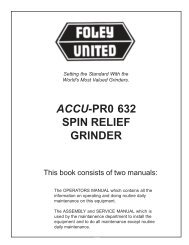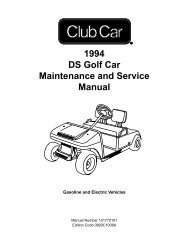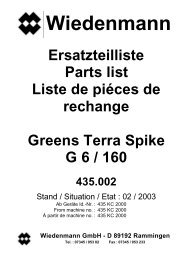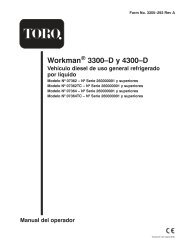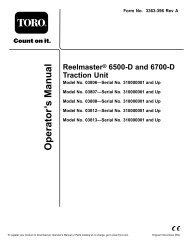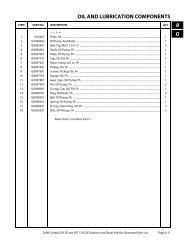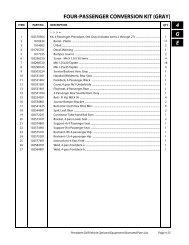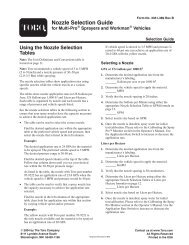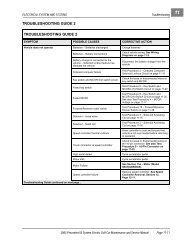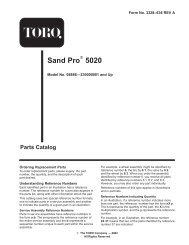BUSH
Operator's Manual 307 SERIES ROTARY CUTTERS - Caribe Turf
Operator's Manual 307 SERIES ROTARY CUTTERS - Caribe Turf
- No tags were found...
Create successful ePaper yourself
Turn your PDF publications into a flip-book with our unique Google optimized e-Paper software.
3-3 OPERATION<br />
A. Perform BEFORE EACH USE maintenance<br />
listed in paragraph 4-1.<br />
B. Start tractor.<br />
C. With tractor at idle speed, engage PTO drive.<br />
D. Adjust cutter to working position.<br />
DANGER<br />
STAY CLEAR OF ROTATING DRIVELINE. DO<br />
NOT OPERATE WITHOUT DRIVELINE<br />
SHIELDS IN PLACE AND IN GOOD CONDI-<br />
TION. FAILURE TO HEED THESE WARNINGS<br />
MAY RESULT IN PERSONAL INJURY OR<br />
DEATH.<br />
E. Set tractor throttle for appropriate PTO speed<br />
(540 RPM).<br />
DANGER<br />
ROTATING CUTTER BLADES. STAND<br />
CLEAR UNTIL ALL MOTION HAS STOPPED.<br />
TO AVOID AN ACCIDENTAL FALL FROM<br />
THE TRACTOR AND POSSIBLE INJURY BY<br />
THE MOWER, IT IS RECOMMENDED THAT<br />
THE TRACTOR BE EQUIPPED WITH ROPS<br />
(ROLLOVER PROTECTIVE SYSTEM) AND<br />
THAT A SEAT BELT BE USED BY THE OPER-<br />
ATOR FOR ALL MOWING OPERATIONS.<br />
F. Place tractor in gear and begin cutting. Tractor forward<br />
speed should be controlled by gear selection,<br />
4-1 MAINTENANCE CHECK LIST<br />
Perform scheduled maintenance as outlined below.<br />
Lower machine to ground, turn off tractor and set parking<br />
brake before doing maintenance inspections or work.<br />
Some checks may require raising machine off ground<br />
and supporting with blocks. All bolts should be torqued<br />
as recommended in the torque specifications chart<br />
unless otherwise indicated.<br />
WARNING<br />
THE CUTTER CAN FALL FROM HYDRAULIC<br />
SYSTEM FAILURE. TO AVOID SERIOUS<br />
INJURY OR DEATH, SECURELY SUPPORT<br />
CUTTER BEFORE WORKING UNDERNEATH.<br />
BEFORE EACH USE<br />
1. Check tractor tire air pressure. Refer to tractor<br />
operator’s manual.<br />
2. Check blades and spindle to be sure that no foreign<br />
objects such as wire or steel strapping bands<br />
are wrapped around them.<br />
3. Check blade bolts for tightness. Tighten to 450<br />
ft./lbs. (609 Nm).<br />
4. Inspect blades for wear. Replace if necessary per<br />
paragraph 4-4. Always replace both blades on<br />
SECTION IV<br />
MAINTENANCE<br />
10<br />
not engine speed. For maximum cutting efficiency, forward<br />
speed should allow cutter to maintain a constant,<br />
maximum blade speed. Do not exceed 5 mph (8kph). If<br />
PTO drive is disengaged due to cutter stalling or tractor<br />
engine bogging, cutter must be moved to a “cut” area and<br />
tractor throttle reduced to idle before re-engaging.<br />
Always cut up and down the face of slopes, never across.<br />
WARNING<br />
ALL ROTARY CUTTERS HAVE THE ABILITY<br />
TO DISCHARGE OBJECTS AT HIGH SPEEDS<br />
WHICH COULD RESULT IN SERIOUS INJURY<br />
TO BYSTANDERS OR PASSERS-BY.<br />
THEREFORE, THIS CUTTER IS NOT TO BE<br />
OPERATED ALONG HIGHWAYS OR IN ANY<br />
AREA WHERE PEOPLE MAY BE PRESENT<br />
UNLESS ALL SIDES OF THE UNIT ARE<br />
ENCLOSED BY PERMANENT BANDS, SAFE-<br />
TY CHAINS, OR OTHER FACTORY APPROV-<br />
ED SAFETY SHIELDS THAT ARE IN GOOD<br />
REPAIR. CEASE MOWING WHENEVER ANY-<br />
ONE COMES WITHIN THE OPERATING AREA.<br />
3-4 TRANSPORTING<br />
When implement is transported on road or highway, day<br />
or night, use tractor flashing warning lights unless prohibited<br />
by law. A slow moving vehicle (SMV) sign must be<br />
visible from the rear by approaching vehicles. Do not<br />
exceed 15 mph (24kph) when traveling. Fully raise<br />
implement before transporting.<br />
spindle with two blades equal in weight. Use<br />
only genuine Bush Hog replacement parts.<br />
5. Make certain driveline shields are in place and in<br />
good repair to minimize entanglement injuries to<br />
persons by rotating drivelines.<br />
6. Make certain deflector shields (chains, bands, etc.)<br />
are in good repair to minimize injuries to persons by<br />
the discharge of the high speed thrown objects.<br />
7. Inspect wheel(s) for wear, damage, or foreign<br />
objects.Repair or replace if necessary.<br />
8. Perform BEFORE EACH USE lubrication per paragraph<br />
4-2.<br />
9. During operation, listen for abnormal sounds which<br />
might indicate loose parts, damaged bearings or<br />
other damage.<br />
AFTER EACH USE<br />
1. Clean all debris from machine especially underside of<br />
deck and affixed safety decals. Replace any missing<br />
or illegible decals.<br />
2. Inspect cutter for worn or damaged components.<br />
Repair/replace before next use. Any replacement<br />
components installed during repair shall include the<br />
components current safety decals specified by the<br />
manufacturer to be affixed to the component.



